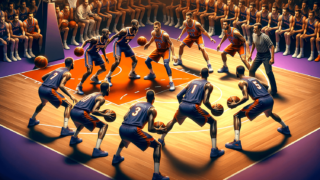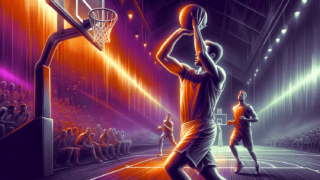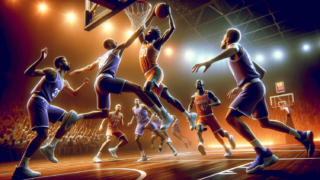
How to Become a Better Off-Ball Defender in Basketball?
Written by: Basketball Universe
Last updated:

Every basketball player knows that a strong defense can make or break a game, but while on-ball defense tends to steal the spotlight, off-ball defense is often the hidden key to a team’s success. In this blog post, we’ll dive deep into the art of becoming a better off-ball defender, providing useful tips and insights to elevate your game to new heights. Whether you’re a weekend warrior or an aspiring professional, sharpening your off-ball defensive skills will not only help you lock down opposing players but also make you an invaluable asset on any team. So lace up your sneakers, grab a notepad, and let’s discover how you can become the ultimate off-ball defender!
How to Become a Better Off-Ball Defender in Basketball?
To become a better off-ball defender in basketball, focus on improving your defensive awareness, positioning, and footwork. Stay alert and maintain constant communication with your teammates to understand the opposing team’s offensive strategy. Master the art of navigating screens and adjusting your position to anticipate the offensive players’ movements. Additionally, fine-tune your footwork, lateral quickness, and agility, as these skills will help you close out on shooters and contest shots more effectively.
Mastering Defensive Awareness
Improving your defensive awareness is an essential first step to becoming a better off-ball defender. It involves understanding the offensive patterns and strategies of your opponents, anticipating their moves, and reacting accordingly. By developing your defensive awareness, you’ll be better equipped to defend your opponents and be a valuable asset to your team.
Watch and Learn from the Pros
An excellent way to boost your defensive awareness is by studying professional basketball players. Focus on those renowned for their off-ball defensive skills, such as Scottie Pippen, Kawhi Leonard, and Tony Allen. Observe their positioning on the court, how they respond to specific plays or situations, and the tactics they use to disrupt the opposing team’s offense. You can learn a lot from watching these players and incorporating their strategies into your own game.
Scouting Your Opponents
Another critical aspect of building defensive awareness is understanding your opponents’ strengths and weaknesses. This means studying their individual and team tendencies, knowing which players are strong shooters or extremely fast, and being familiar with their offensive plays. With this knowledge in hand, you’ll be better prepared to navigate through screens, deny open shots, and make smart decisions that generate turnovers.
Perfecting Positioning and Footwork
The art of positioning, footwork, and overall agility are integral components of becoming a stellar off-ball defender. Mastering these skills allows you to stay in front of your man, fight through screens, and react quickly on defense without losing your balance.
Stance and Balance
The foundation of effective off-ball defense begins with a proper defensive stance. Maintain a low, balanced posture with your knees bent, feet shoulder-width apart, and your weight centered between your toes and heels. Keep your back straight, head up, and maintain active hands, ready to deflect or intercept passes. A strong stance enables you to react more quickly to the offensive player’s movements, whether they are cutting, setting a screen, or trying to get open for a shot.
Moving with Purpose and Agility
As an off-ball defender, your footwork should be precise, agile, and efficient. Practice taking quick, powerful steps to close out on shooters without losing your balance or overcommitting. Additionally, work on moving laterally with quickness, as this is essential when following your assigned player around the court, fighting through screens, and rotating on defense.
Practicing Footwork Drills
Integrating specific footwork drills into your practice routine can help improve your reactions, speed, and general agility on defense. Some drills you can try include ladder or cone drills, defensive slides, cutting and sprinting exercises, and reaction-based activities that require you to change directions quickly.
Navigating Through Screens
In basketball, screens are a common part of offensive strategies to create open shots or mismatches. Off-ball defenders must learn how to effectively navigate these screens to deny the offense any advantage.
Fighting Through Screens
When faced with a screen, it’s crucial to communicate with your teammates and get ready to fight through it. Depending on the situation, you might have to “switch” with a teammate or “hedge” to slow down your opponent until you can recover your position. Practice various techniques to get through screens, such as going over or under the screen, and work on staying low and agile to move around quickly.
Identifying and Anticipating Screen Actions
The sooner you can identify a screen, the more time you have to prepare and react. Analyze opposing teams’ plays to understand which players are likely to set screens and their preferred screen actions. Armed with this knowledge, you’ll be able to anticipate screens and react accordingly, reducing the likelihood of your opponent breaking free for an open shot.
Contesting and Deflecting Shots
An essential skill for an off-ball defender is being able to contest or deflect shots effectively. This means being agile enough to close out on shooters quickly, disrupting their rhythm, and making it difficult for them to get a clean shot off.
Quick and Controlled Closeouts
Closeouts are a cornerstone of effective off-ball defense. Your goal is to apply heavy pressure on the shooter, forcing them to take contested shots while preventing them from driving past you. Quick and controlled closeouts can make a significant difference in their shooting percentages, and mastering this skill drastically improves your overall off-ball defense.
Hand Placement and Timing
When contesting shots, hand placement and timing play a pivotal role. Your lead hand should be high enough to challenge the shot, while the other hand is ready to prevent any drive. React quickly and avoid jumping for a block. Instead, contest shots with your hands extended to cover any last-minute shot attempts without compromising your defensive position.
Communication and Teamwork
Finally, becoming a better off-ball defender requires honing your communication and teamwork skills. Remember, basketball is a team sport, and effective off-ball defense demands constant communication and coordination with your teammates.
Talk with Your Teammates
Consistently communicate with your teammates on the court, calling out screens, backdoor cuts, and other relevant information. Early and clear communication allows your team to make the necessary adjustments and maintain the overall defensive structure.
Developing Court Awareness
Aside from focusing on your individual matchup, it’s essential to develop court awareness, which involves knowing the locations of your teammates, opponents, and the ball. Proper court awareness will enable you to make better defensive decisions, including rotating to help other defenders or contesting open shots.
By diligently working on these elements and incorporating them into your basketball game, you’ll be well on your way to becoming a more effective off-ball defender. Confidence, persistence, and attention to detail are vital factors in your journey to elevate your off-ball defense to a higher level. Dedicate yourself to continuous improvement, and you’ll surely be an asset to any team.
Understanding and Exploiting Opponent’s Weaknesses
Capitalizing on your opponents’ weaknesses can significantly enhance your off-ball defense, making it harder for them to get open or create scoring opportunities. Pay close attention to the tendencies of the player you’re guarding, and use this information to anticipate their movements and disrupt their game plan.
Study Game Film
Watching game film is invaluable for understanding your opponents and their playing styles. By identifying players who exhibit poor footwork, struggle to maintain correct spacing, or have a weak shooting hand, you can effectively disrupt their offensive rhythm on the court. Invest time in studying game film to familiarize yourself with these habits, as they will inform your decision-making during actual games.
Know Their Preferred Moves
Every player has preferred moves they rely on while trying to get open or create scoring opportunities. By being aware of these tendencies, you can better anticipate their actions and work to shut them down. For example, if you’re guarding a player who frequently uses screens to get open for a shot, you’ll know to keep an eye out for this move and be prepared to fight through screens or communicate necessary switches with your teammates.
Physical and Mental Conditioning
Physical and mental fitness play significant roles in your off-ball defensive capabilities. Implementing a consistent training regimen and nurturing the right mindset will make you more resilient and adaptive on the court.
Physical Conditioning
Enhancing your speed, strength, and overall athleticism will contribute to your off-ball defense, allowing you to move more quickly and efficiently on the court. Incorporate strength training, plyometrics, and agility exercises into your workout routine to build the necessary physical attributes for top-notch off-ball defense.
Mental Conditioning
A strong mental foundation equips you to deal with the challenges and pressures of basketball, especially on defense. Work on fostering a growth mindset, which will help you adapt and learn from your experiences on the court. Embrace challenges and strive for continuous improvement, both as an individual player and as part of your team.
Development Plan and Practice
Devise a development plan to refine your off-ball defense skills, determining specific areas for improvement and creating a practice schedule that addresses those areas. Consistent, focused practice is critical to making the necessary changes and advancements in your game.
Set Goals and Monitor Progress
Establish measurable, attainable goals for your off-ball defense development. These goals could range from improving your closeout speed to mastering the art of fighting through screens. Regularly track your progress toward these goals, adjusting your development plan as needed to maximize your improvement.
Focused and Deliberate Practice
Quality practice is vital for growth, so dedicate ample time to improving your off-ball defense. Emphasize focused and deliberate practice sessions, targeting specific skills, and working on them intently. Engage with coaches and teammates for feedback and support, as they can provide invaluable insights and guidance throughout your development process.
By giving attention to these essential aspects of off-ball defense, you’ll cultivate a well-rounded, versatile skill set – a competitive edge that every basketball player aspires to achieve. Commit to continuous learning and improvement, and watch as your hard work translates into on-court success.
FAQ: Off-Ball Defense in Basketball
Let’s tackle some frequently asked questions about off-ball defense in basketball to address any curiosities or concerns you may have. These answers will help you optimize your learning experience and ensure a comprehensive understanding of this essential aspect of the game.
1. What skills are most important for off-ball defense?
Defensive awareness, positioning, footwork, navigating screens, contesting shots, communication, and teamwork are crucial skills for effective off-ball defense. Developing these abilities will help you thrive on this side of the court and be a valuable defensive asset to your team.
2. How can I improve my defensive footwork?
Practice agility, balance, and quickness through ladder or cone drills, defensive slides, cutting and sprinting exercises, and reaction-based activities that demand rapid changes in direction. Focused and consistent training will enhance your defensive footwork substantially over time.
3. What is the proper defensive stance?
A solid defensive stance involves maintaining a low, balanced posture with knees bent, feet shoulder-width apart, and weight centered between your toes and heels. Keep your back straight, head up, and hands active, ready to deflect or intercept passes.
4. How can I anticipate screens?
Anticipating screens is achieved through studying game film and being familiar with your opponents’ offensive plays. Understanding their individual and team tendencies, including the players likely to set screens, allows you to foresee these actions and react accordingly.
5. How can I improve my ability to contest shots?
Concentrate on closing out on shooters quickly and with control, maintaining proper hand placement and timing. React rapidly, and focus on extending your hands to cover potential shot attempts without compromising your defensive position.
6. How can communication improve off-ball defense?
Effective communication helps maintain your team’s defensive structure, enabling swift adjustments to screens, backdoor cuts, and other offensive actions. Constant, clear communication with teammates is essential for coordinated, cohesive off-ball defense.
7. How important is understanding my opponent’s weaknesses?
Grasping your opponents’ strengths and weaknesses is pivotal, as it allows you to anticipate and disrupt their game plan more effectively. Studying and exploiting these tendencies can significantly enhance your off-ball defense capabilities.
8. How do physical and mental conditioning contribute to off-ball defense?
Physical conditioning boosts speed, strength, and agility, amplifying your off-ball defensive efficiency. Mental conditioning, on the other hand, instills the resilience and adaptability necessary to navigate on-court challenges and pressures effectively.
9. How can I devise a development plan?
Identify specific areas of improvement, establish measurable, attainable goals, and create a practice schedule that addresses those target areas. Monitor your progress regularly and adjust your plan as needed to optimize your off-ball defensive development.
10. Why is deliberate practice essential?
Deliberate practice involves focused, targeted training that hones specific skills, leading to substantial improvements in technique and execution. Engaging in deliberate practice sessions will accelerate your progress and contribute to your off-ball defensive excellence.
Featured Posts
- No pillar pages found.





